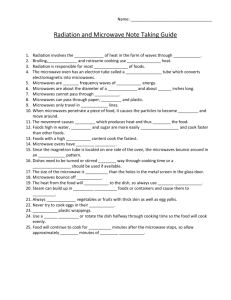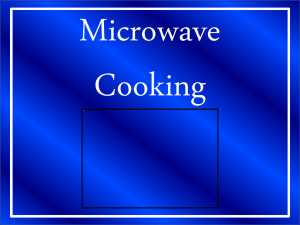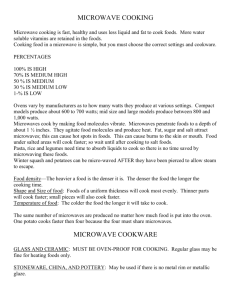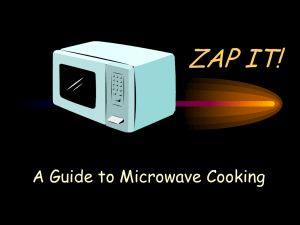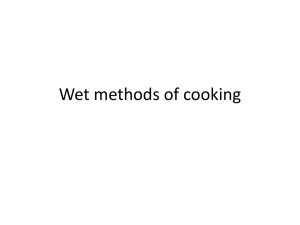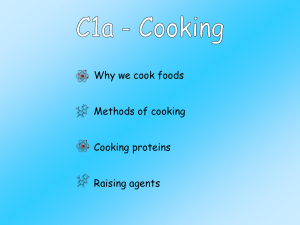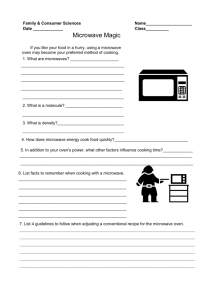Microwave Cooking info
advertisement
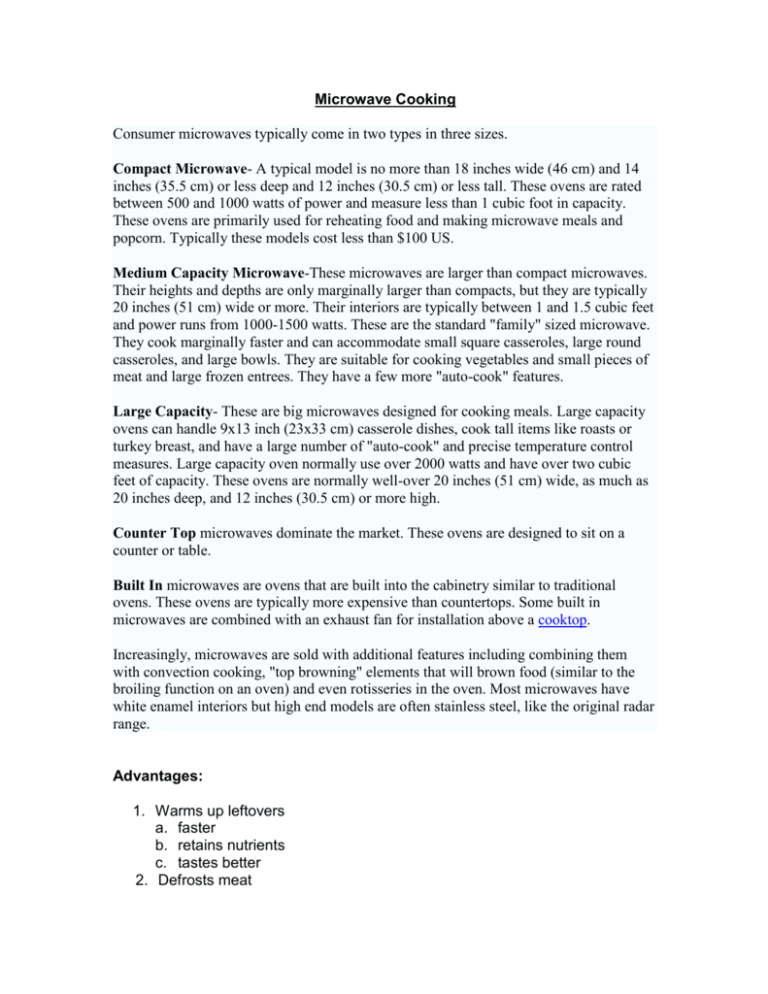
Microwave Cooking Consumer microwaves typically come in two types in three sizes. Compact Microwave- A typical model is no more than 18 inches wide (46 cm) and 14 inches (35.5 cm) or less deep and 12 inches (30.5 cm) or less tall. These ovens are rated between 500 and 1000 watts of power and measure less than 1 cubic foot in capacity. These ovens are primarily used for reheating food and making microwave meals and popcorn. Typically these models cost less than $100 US. Medium Capacity Microwave-These microwaves are larger than compact microwaves. Their heights and depths are only marginally larger than compacts, but they are typically 20 inches (51 cm) wide or more. Their interiors are typically between 1 and 1.5 cubic feet and power runs from 1000-1500 watts. These are the standard "family" sized microwave. They cook marginally faster and can accommodate small square casseroles, large round casseroles, and large bowls. They are suitable for cooking vegetables and small pieces of meat and large frozen entrees. They have a few more "auto-cook" features. Large Capacity- These are big microwaves designed for cooking meals. Large capacity ovens can handle 9x13 inch (23x33 cm) casserole dishes, cook tall items like roasts or turkey breast, and have a large number of "auto-cook" and precise temperature control measures. Large capacity oven normally use over 2000 watts and have over two cubic feet of capacity. These ovens are normally well-over 20 inches (51 cm) wide, as much as 20 inches deep, and 12 inches (30.5 cm) or more high. Counter Top microwaves dominate the market. These ovens are designed to sit on a counter or table. Built In microwaves are ovens that are built into the cabinetry similar to traditional ovens. These ovens are typically more expensive than countertops. Some built in microwaves are combined with an exhaust fan for installation above a cooktop. Increasingly, microwaves are sold with additional features including combining them with convection cooking, "top browning" elements that will brown food (similar to the broiling function on an oven) and even rotisseries in the oven. Most microwaves have white enamel interiors but high end models are often stainless steel, like the original radar range. Advantages: 1. Warms up leftovers a. faster b. retains nutrients c. tastes better 2. Defrosts meat 3. 4. 5. 6. 7. a. turn the food b. separate the pieces c. allow large items to stand for complete defrosting d. use immediately Softens brown sugar if used immediately (Put 1 cup of water in microwave) Plumps raisins Freshens snacks and chips Eliminates extra oils and fats in preparing foods Has made a great impart on today’s lifestyles and cooking habits. 8. Cook foods quickly with higher quality, tastes better, looks better and color enhanced. The microwave oven has been around since 1945. Acceptable dishes for the microwave: 1. 2. 3. 4. paper plastic glass microwaveable dishes Unacceptable dishes for the microwave: 1. metal 2. dishes with gold or silver on it Acceptable coverings for microwave dishes: 1. paper towels - to absorb moisture, spatters, and spills 2. wax paper - holds in some of the moisture 3. plastic wrap - hold in moisture Foods that should not be microwaved: 1. 2. 3. 4. eggs in shells - they explode or burst when heat builds up. pancakes - they don’t get a crust on them. popcorn - not enough moisture in regular popcorn canning foods - does not get high enough temperature or have enough pressure. 5. deep-fry foods - fat temperature can not be controlled. 6. large amounts of food - takes too long, not as efficient Techniques for Microwaving: 1. Stirring - To pull heated part of the food to the center. 2. Turning over - To microwave all sides. 3. Standing time - To allow the foods to complete its cooking (place directly on counter). 4. Shielding - Small pieces of foil used to cover wings or legs of poultry (deflects microwaves away from that part). 5. Covering - a. Retains nutrients, b. Holds in moisture, c. Speeds up cooking. 6. Arrange food in circular shape - to make cooking even. 7. Rotating - Makes cooking even. 8. Pricking - (egg yolks and potatoes) to keep from exploding. 9. Select foods of the same size - cooks evenly Cooking Hints: 1. Foods at refrigerator and freezer temperatures take longer to cook than those at room temperature. 2. Density affects cooking time (dense foods - potato) 3. Bony pieces of chicken - put on outside 4. Microwaved cook by entering the foods by the outside edges. Cooking Tips: 1. Microwave containers include: plastic, paper and glass. Never put metal or foil items in the microwave. 2. Cover containers with plastic wrap, paper towels, wax paper, or a lid. 3. By covering foods in the microwave, it holds in moisture, helps food cook evenly and prevents food from splattering in the microwave. 4. When microwaving food, microwaves are attracted to fat, sugar and water molecules. 5. When cooking in the microwave, the volume of the food (small versus large potatoes); and the quantity or number will increase cooking and standing time. 6. When cooking, round containers will cook more evenly than food in square containers, which tend to burn in the corners. 7. To help food cook more evenly, stir and rotate foods while cooking; if available a turntable may be used to rotate foods. 8. Standing time at the end of cooking allows for foods to continue to cook when removed. 9. To prevent burning yourself from microwave cooking, remember: a. Foods can create hot containers. b. Items can explode (eggs, potatoes). Piece them with a fork. c. Lifting the cover or plastic from the food can cause a burn. d. Hot steam escaping can cause a burn.

